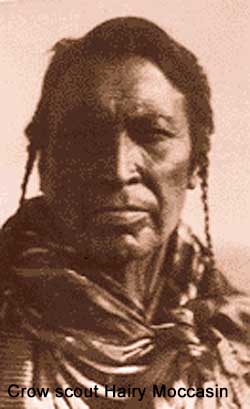|
|||||||||||
Bruce Brown's 100 Voices... Hairy Moccasin's Story of the Battle
When we separated Half-Yellow-Face [Half Yellow Face] and White Swan were ordered to go with Reno. Goes-Ahead, White-Man-Runs-Him, Curley and myself were ordered with Custer. We came down and crossed Reno Creek. Mitch Boyer was ahead with the four scouts right behind. Custer was ahead of his command a short distance behind us. Custer yelled to us to stop, then told us to go to the high hill ahead (the high point just north of where Reno later entrenched). From here we could see the village and could see Reno fighting. He had crossed the creek. Everything was a scramble with lots of Sioux. The battle was over in a few minutes. We thought they were all killed. We four scouts turned and charged north to where Custer was headed for. Three of us stopped to fire into the village. [Note: Here are Sioux warrior White Cow Bull and Crow scout Goes Ahead's description of the exact same moment in the battle.] We saw no more of Curley after that. I don't know where he went. When we met Custer he asked, "How is it?" I said, "Reno's men are fighting hard." We went with the command down into a dry gulch where we could not see the village. Custer told Mitch Boyer to tell us to go back to the pack-train, which we did. We met Benteen's command just south of where they afterward entrenched. We said to Benteen, "Do you hear that shooting back where we came from? They're fighting Custer there now." We started to leave Benteen to join the Ree scouts who were quite a way back up the creek, but Benteen told us to stay, and we did. We went with him and helped dig entrenchments. The firing seemed to stop where Custer was, and the Sioux came toward us. Then Reno's command came back where we were entrenched. Just before sundown the enemy drew off. We had been fighting quite a while. We three scouts got away and rode till we came to the Bighorn, but did not cross that night. It was dark and raining. The next morning some Crow scouts of Bradley's command came along and followed us, where we had crossed the river. They joined us and we all rode to the main Crow camp, two sleeps away on Pryor Creek. This is the way it happened just as near as I can remember. The Custer Battle Book by Herbert Coffeen, A Reflection Book, Carlton Press, Inc., New York, 1964 p 48
This eye-witness account of the Battle of the Little Bighorn by Hairy Moccasin -- one of the four Crow scouts who rode with Custer down Medicine Tail Coulee shortly before Custer was killed -- is important because it shows that Custer knew the Indians weren't running away from Reno, as Half Yellow Face originally reported. Instead, Hairy Moccasin, Goes Ahead and White Man Runs Him told Custer that the free Sioux and Cheyenne were "fighting hard" -- so hard, in fact, that Hairy Moccasin thought Reno's men might have been "all killed," a sentiment echoed by White Man Runs Him. Another Seventh cavalry scout, Fred Gerard, also reported to Custer that the Indians weren't running away, but rather coming out in large numbers to "give us battle." This meant Custer knew he had to attack immediately to keep the much larger Indian force off balance and provide any survivors among Reno's men the support he had promised -- otherwise he had sent Reno and his 112 men on a suicide mission. And this in turn underlines the fact that the ONLY plausible explanation for the timid, rudderless behavior of Custer's doomed command after Custer's failed attack at Medicine Tail Coulee is that Custer was shot trying to cross the river -- as White Cow Bull described, and Pretty Shield confirmed -- and was no longer commanding his men. See Who Killed Custer - The Eye-witness Answer for more info... For more information on Custer's scouts, please see The Twisted Saga of the Unsung Seventh Cavalry Scouts. -- Bruce Brown
|
|||||||||||




 AT THAT TIME I was twenty-four years old, and was an enlisted scout under
AT THAT TIME I was twenty-four years old, and was an enlisted scout under 







